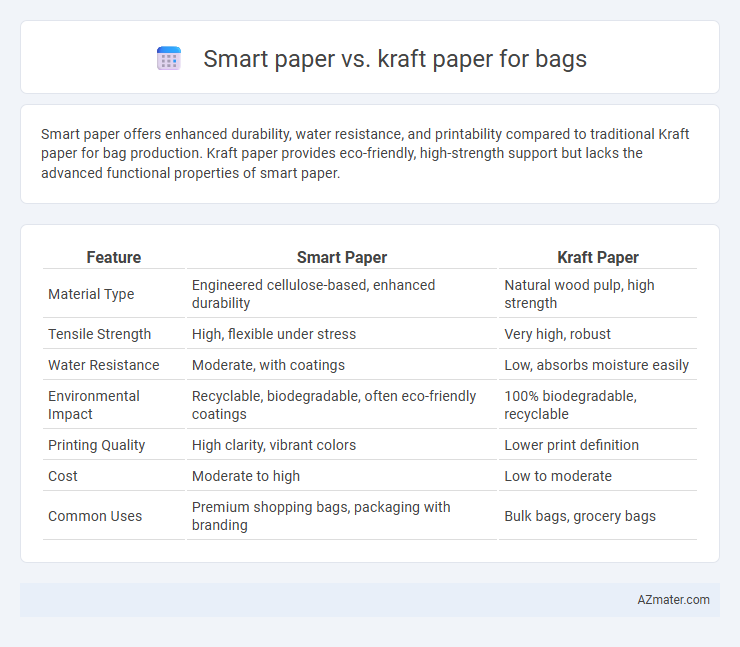Smart paper offers enhanced durability, water resistance, and printability compared to traditional Kraft paper for bag production. Kraft paper provides eco-friendly, high-strength support but lacks the advanced functional properties of smart paper.
Table of Comparison
| Feature | Smart Paper | Kraft Paper |
|---|---|---|
| Material Type | Engineered cellulose-based, enhanced durability | Natural wood pulp, high strength |
| Tensile Strength | High, flexible under stress | Very high, robust |
| Water Resistance | Moderate, with coatings | Low, absorbs moisture easily |
| Environmental Impact | Recyclable, biodegradable, often eco-friendly coatings | 100% biodegradable, recyclable |
| Printing Quality | High clarity, vibrant colors | Lower print definition |
| Cost | Moderate to high | Low to moderate |
| Common Uses | Premium shopping bags, packaging with branding | Bulk bags, grocery bags |
Introduction: The Evolution of Bag Materials
Smart paper and Kraft paper represent significant advancements in sustainable bag materials, reflecting the evolution of eco-friendly packaging solutions. Smart paper integrates innovative technologies like water resistance, tear strength, and recyclability, enhancing durability while minimizing environmental impact. Kraft paper, known for its natural brown color and high tensile strength, remains a popular choice for its biodegradability and cost-effectiveness in producing sturdy, recyclable bags.
What is Smart Paper?
Smart paper refers to advanced packaging material designed to combine durability, sustainability, and functional benefits such as moisture resistance and ink absorbency, making it ideal for bags that require both strength and eco-friendliness. Unlike traditional kraft paper, which is known for its coarse texture and high tensile strength due to unbleached fibers, smart paper incorporates engineered coatings or composites that enhance print quality and provide barrier properties. This innovation allows smart paper bags to deliver superior performance in terms of protection, branding, and environmental impact compared to conventional kraft bags.
What is Kraft Paper?
Kraft paper is a strong, durable paper made from wood pulp through the kraft process, known for its high tear resistance and natural brown color, commonly used for bags requiring heavy-duty strength. It offers excellent tensile strength and moisture resistance, making it ideal for packaging and carrying heavier items. Compared to smart paper, kraft paper is more environmentally friendly due to its biodegradability and recyclability while providing practical durability for various bag applications.
Manufacturing Processes: Smart Paper vs Kraft Paper
Smart paper for bags is manufactured using advanced synthetic fibers combined with biodegradable polymers, resulting in enhanced durability and water resistance through a high-precision coating and lamination process. Kraft paper production involves the kraft pulping process, where wood chips undergo chemical treatment to produce strong, coarse fibers ideal for heavy-duty bags with natural strength and tear resistance. The manufacturing of smart paper emphasizes eco-friendly innovations and surface treatments, whereas kraft paper relies on traditional pulping and refining techniques to achieve robustness.
Strength and Durability Comparison
Smart paper offers superior tensile strength and tear resistance compared to kraft paper, making it more suitable for heavy-duty bags. Kraft paper, while durable, typically has lower burst strength and can weaken when exposed to moisture, reducing its overall lifespan. The enhanced fiber composition and coating technologies in smart paper significantly improve durability, ensuring longer-lasting bag performance under stress and environmental conditions.
Environmental Impact and Sustainability
Smart paper offers enhanced environmental benefits over kraft paper by incorporating recycled fibers and biodegradable additives, reducing overall carbon footprint and waste production. Kraft paper, while durable and widely recyclable, often involves higher energy consumption during production and may rely on virgin wood pulp, impacting deforestation rates. Choosing smart paper for bags supports greater sustainability through improved resource efficiency and lower environmental impact throughout the lifecycle of the product.
Cost-Effectiveness and Pricing Analysis
Smart paper typically offers enhanced durability and print quality compared to kraft paper, often resulting in higher initial costs but greater long-term value due to reduced damage and improved branding impact. Kraft paper remains a cost-effective choice for budget-conscious businesses, providing adequate strength and recyclability at a lower price point, making it ideal for simple, eco-friendly packaging. Pricing analysis reveals that while smart paper commands a premium, its benefits justify the investment for premium product lines, whereas kraft paper suits high-volume, low-margin operations focused on sustainability.
Printability and Customization Options
Smart paper offers superior printability with high-resolution ink compatibility, enabling vibrant, detailed graphics and precise branding on bags. Kraft paper, while eco-friendly and durable, provides a more rustic texture that may limit fine print quality but supports natural, minimalist designs. Customization options in smart paper include varied finishes and coatings for enhanced visual appeal, whereas kraft paper excels in organic, handcrafted aesthetics with fewer print customization capabilities.
Use Cases: Best Applications for Each Paper Type
Smart paper excels in premium retail bags and gift packaging due to its smooth surface and printability, ideal for high-quality graphics and branding. Kraft paper is best suited for heavy-duty grocery bags, eco-friendly shopping bags, and industrial packaging because of its durability and tear resistance. Both papers serve distinct needs: smart paper for aesthetic appeal and marketing impact, kraft paper for strength and sustainability in everyday use.
Conclusion: Choosing the Right Paper for Your Bags
Smart paper offers enhanced strength, moisture resistance, and a smoother surface suitable for high-end or durable bags, while Kraft paper provides eco-friendly, cost-effective, and recyclable qualities ideal for everyday use. The choice depends on the bag's purpose, required durability, and environmental priorities. For premium branding and longer lifespan, smart paper is preferable; for sustainability and budget, Kraft paper remains the best option.

Infographic: Smart paper vs Kraft paper for Bag
 azmater.com
azmater.com